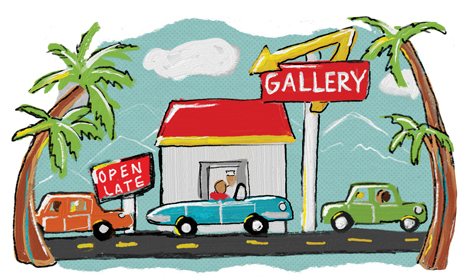Your cart is currently empty!
DECODER

Art does not want us to look at art the way we are asked to look at art. Coming in, worried about making it in time to get to the next gallery and the next, anticipating dinner, standing, not knowing how long the video will go on, not knowing if the next gallery will be worth it, avoiding fellow visitors, quickly passing the worst work, thirsty, standing in front of something that might be good, evaluating out of an obligation to know you looked at it, trying hard to drag out the one moment of actual contact with something worth seeing, then leaving, and the best you can get is the hope of some revelation in reflection in the car on the way to do (or if you’re lucky: see) the next thing. And hoping you spent as much time at the show as you did finding parking.
Openings, fairs and artwalks offer a slight improvement, but only by slotting the art into the background of an already solidly tested formula: alcohol and other people. The worst art can’t make good company bad and the best art won’t save you if you’re surrounded by talking assholes. If art only functions well under these conditions, it’s doomed.
Ideally, art should be able to be regularly shown and seen in such a way that, if you need it to, it alone can save you. You should be able to visit it alone, casually, sit on a squishy couch, look for a long time, think and experience an experience determined by that art and not by the conditions created by having had to wedge the art into your day. It should be given the opportunity to take you when you’ve been destroyed and remind you that there are more possibilities than you knew. It should be allowed at the very least the same opportunity for cognitive infiltration we let any given TV show have. A stranger should come into the gallery about once every 10 minutes—just often enough that you don’t feel obligated to talk to them, but rare enough that if they want to look at the art as much as you do then you can talk about it. Then, if they’re interesting or good-looking or both, you should be able to walk with them to see more art, and talk about ideas, then get sandwiches—big ones, not thin consolation-prize art-neighborhood ones with sprouts—then get drunk and see more art.
The way Los Angeles metabolizes art is an exaggeration of the American media’s Nietzschean attitude toward fun: entertainment which doesn’t kill you makes you stronger. All diversion is coded as either self-destructive or self-improvement. And self-improvement makes you better, and being better is good for your personal brand and is a responsibility and is supposedly part of everyone’s increasingly panoptic packing list of things you might need to get through the 20teens (thus so much interactive and “relevant” art: you feel like you’re doing something). You look at art because you might “get something out of it” and the city’s art galleries and museums are scattered like gyms or filling stations—meanwhile keeping hours based on traffic patterns imported from a SoHo-centric art world that no longer exists even in New York.
In that long-vanished scene, frighteningly genuine attempts to make new art were never more than a block from a cheap slice, a beer, a bar, a school, and from some place actual artists and people who wrote about art actually lived. This isn’t how LA rolls, and galleries and museums are trying to get used to it and find ways to embed gallery-going into the organic life of a city totally not at all set up for that even a little. Driving across town in the middle of a day just to go to one place is the worst thing that could ever happen to anyone in LA and dealers aren’t stupid: Chinatown was a decent idea, Downtown and Hollywood are a little better—if still not quite there in the execution. LA’s good, smart galleries should take a hint from its bad, cheesy ones: be open at night, be comfortable, have somewhere to sit, have a balcony, be near a movie theater and more than one thing open until at least four, maybe the defaulting to a white cube.
Modernism was built on the promise that you could walk broke through Paris in the rain and fetch up by chance off an alley in front of a picture of something that would redeem those long, lone stretches of dead time, movies live in the space between the springy red cushions and the armrest ready for your jumbo Sprite. The new art needs to imagine a space it can believe in itself occupying in peoples’ lives, and build toward it.